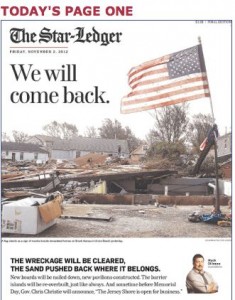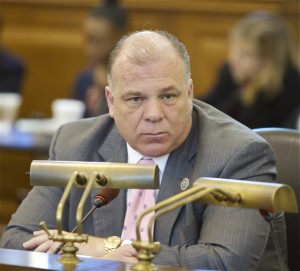Whether to Rebuild The Jersey Shore Is Now on the Table
- The “Frankenstorm” should be a teachable moment to show how “extreme weather” and lax regulations of greenhouse gas emissions and coastal over-development have put thousands of people and billions of dollars of property in harms way. … The storm should be a clarion call for finally addressing the rising global warming crisis. (Bill Wolfe, 10/26/12
- Houses are built upon dunes, grasses destroyed, dunes breached for beach access and housing; groundwater is withdrawn with little control, areas are paved, bayshore is filled and urbanized. Ignorance is compounded with anarchy and greed to make the raddled face of the Jersey shore. (Ian McHarg – quoted at Wolfenotes – 10/29/12)
- “When the North Carolina coast started being developed heavily we coastal scientists used to say ‘What we need is a big storm.’ We figured that people would see what a storm did and heed its warning. But then Hurricane Hugo hit and we learned that people start building again as soon as the wind dies down. Hurricanes have actually become giant urban renewal projects. The buildings come back bigger than before. But of course the site they are building on is even more dangerous because the shoreline has retreated landward and the dunes have been damaged. But still they re-build. It’s really a form of societal madness. I can’t put it any more strongly.” Prof. Orrin Pilkey, Salon – 11/3/12)
- Now is the time to discuss strategic retreat from high hazard coastal areas, develop a plan for adaptation to climate change, and get serious about accelerating an emergency transition away from fossil fuels to renewable energy. (Bill Wolfe – Wolfenotes – 11/10/12)
- We have this insane mentality, this boosterism along the coast,” said Wolfe, the former state environmental official in New Jersey. “For years and years, people have been putting up warning flags. The state has known this, and instead of regulating more restrictively they’ve pushed right ahead.” (Bill Wolfe – Huffington Post – 11/12/12)
- But this “let’s come back stronger and better” attitude, though empowering, is the wrong approach to the increasing hazard of living close to the rising sea. Disaster will strike again. We should not simply replace all lost property and infrastructure. Instead, we need to take account of rising sea levels, intensifying storms and continuing shoreline erosion. Orrin Pilkey, Professor, Duke University (NY Times Op-Ed –11/14/12)
- “People keep saying we’re going to put everything back the way it was,” said Stephen Sweeney, the Democratic president of the New Jersey state senate. “No, we’re not. It makes no sense to do the same thing over and over again, throwing good money after bad.” (Wall Street Journal – 11/17/12)
Oh my, how the debate has evolved!
Does anyone still remember this disgusting drivel full page cover story “We Will Come Back” and photo from the 11/2/12 Star Ledger? – a piece I called the “most irresponsible Page One – Ever” in an email to my Ledger friends:
The wreckage will be cleared, the sand pushed back where it belongs.
New boards will be nailed down, new pavilions constructed.
The barrier islands will be re-overbuilt, just like always.
And sometime before Memorial Day, Gov. Christie will announce, “The Jersey Shore is open for business.”
It has to be.
Right.
I am pleased to admit I was wrong in predicting that the mainstream media would not engage the isssue of “strategic retreat” – whether to rebuild the Jersey shore.
And I must say that I am shocked that NJ Senate President Sweeney is leading that debate, and saying and doing all the right things (except for pushing the global warming side of the story). So, let’s repeat that WSJ story quote:
“People keep saying we’re going to put everything back the way it was,” said Stephen Sweeney, the Democratic president of the New Jersey state senate. “No, we’re not. It makes no sense to do the same thing over and over again, throwing good money after bad.”
On Wednesday, the New York Times ran a superb Op-Ed by Orrin H. Pilkey, We Need to Retreat From the Beach
But an Op-Ed is to be expected – it is not editorial news judgement on how to cover the story (and the global warming aspect is still largely ignored).
Alas, today, the Wall Street Journal broke the ice and framed the question succinctly:
But with the federal budget deep in the red and government flood insurance still straining to recover from Hurricane Katrina, Sea Bright and other coastal towns face questions over not just how to rebuild in a way that defends lives and property against surging sea levels and more intense storms, but whether to rebuild at all.
Sandy’s destructive path has united an unlikely coalition of free-market think tanks, environmentalists, business owners and insurers arguing the moral hazard of rebuilding in coastal zones that might best be returned to nature.
“It’s very difficult to get beyond the sympathy factor,” said Orrin Pilkey, a coastal geologist at Duke University. “But it works against us.” He said he knows the issue firsthand: Hurricane Camille in 1969 damaged his parents’ Mississippi home. Hurricane Katrina later obliterated it.
“We are subsidizing, even encouraging, very dangerous development,” he said. “It’s amoral, really, that our government continues to blindly and stupidly do this.”
Now that’s something to chew on.
So, enjoy the gorgeous weekend –
Next week, we begin to explore how a “strategic retreat” might be engaged. (Here’s a teaser)





